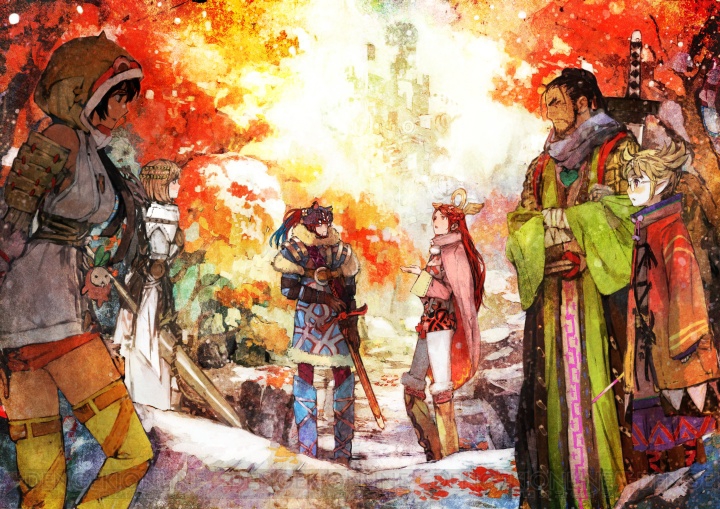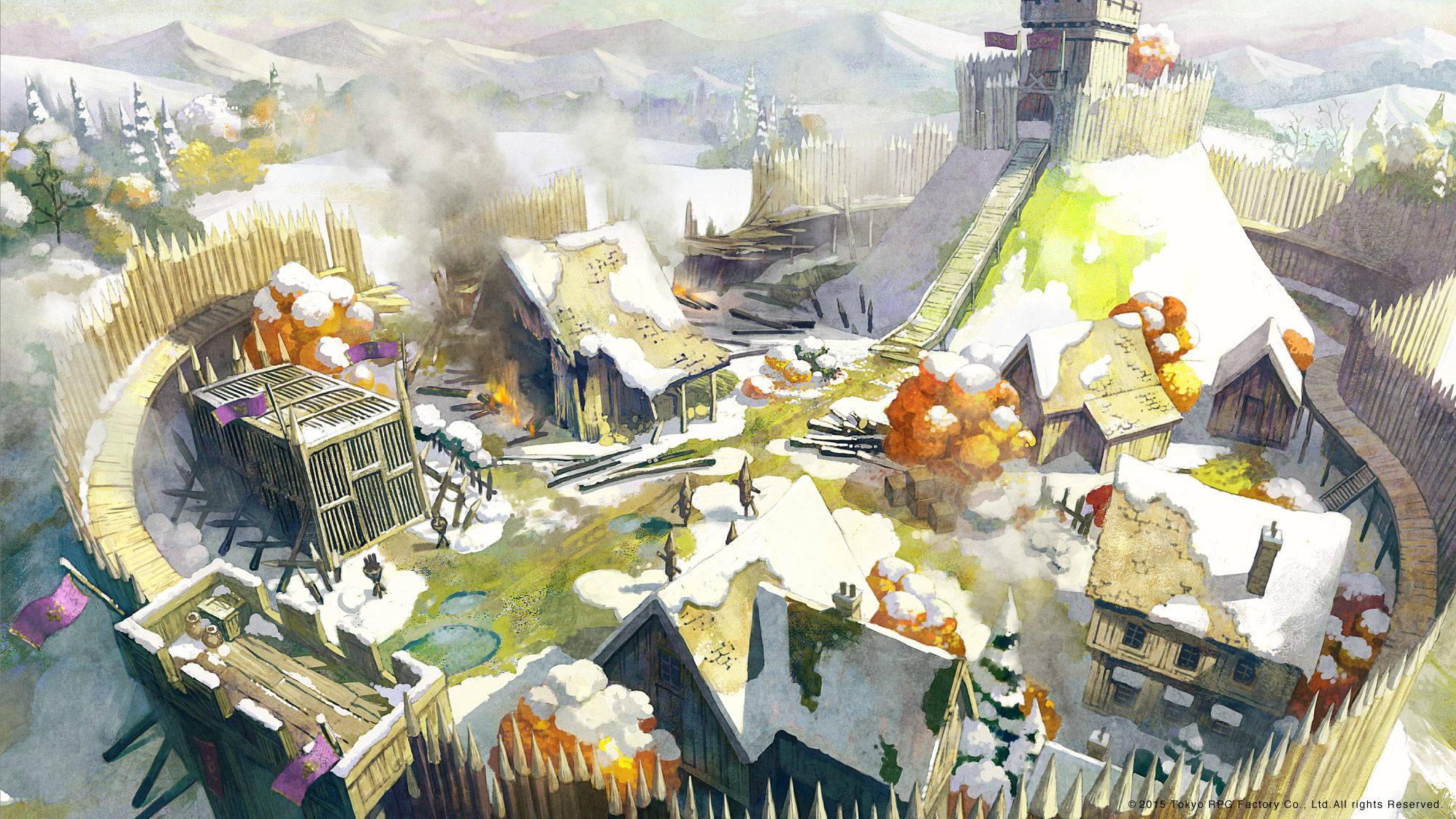From January 29 to February 18, 2016, PlayStation Japan ran a 4-part interview with Dengeki Game Media’s Editor-in-Chief, Satoshi Eguchi, and Square Enix/Tokyo RPG Factory staff on its blog.
The topic of discussion was Tokyo RPG Factory’s debut game, Ikenie to Yuki no Setsuna (“Setsuna of the Snow and Sacrifice,” also “Ephemerality of Snow and Sacrifice”). In March 2016, Square Enix announced that Ikenie to Yuki no Setsuna would be released overseas on PS4 and Steam platforms in Summer 2016 under the title I Am Setsuna.
This is a translation of part 2 of the interview, which focuses on the conception of Setsuna’s story, the meaning of the game’s Japanese title, and the theme of sorrow (in Japanese, setsunasa). The first part can be read here. The last translated part––which includes a message from Tokyo RPG Factory to fans––is forthcoming.
Dengeki Game Media Editor-in-Chief asks Setsuna’s producer and director about the game’s story.
Continued from Part 1. This time Producer Kengo Uchibori and Director Atsushi Hashimoto discuss the contents of the game.
Participants:
Kengo Uchibori – Tokyo RPG Factory, Ikenie to Yuki no Setsuna Producer
Atsushi Hashimoto – Tokyo RPG Factory, Ikenie to Yuki no Setsuna Director
Satoshi Eguchi – Dengeki Game Media, Editor-in-Chief
“Sorrow” and the meaning behind the title
Satoshi Eguchi (hereafter “Eguchi”): When the project name first came up at E3, and then afterward when the official title was announced to be Ikenie to Yuki no Setsuna (“Setsuna of the Snow and Sacrifice”), I thought to myself, “Whoa!” It’s a title that strikes a chord, so I’d like to know, what is the aim of giving the game such a title?
Kengo Uchibori (hereafter “Uchibori”): At first, we had this concept of wanting to “create entertainment that wouldn’t grow dull even after a decade has passed.” What if people were to look at just the title, wonder what kind of game this is, and then become interested in it? With those thoughts in mind, we selected words that then became a title.
Atsushi Hashimoto (hereafter “Hashimoto”): Actually, we also aimed to have players say, “This was a snowy RPG,” after they’ve finished the game and look back on it.
Uchibori: In addition to that, I personally feel that “sorrow” exudes a strong “Made in Japan” impression, so we entwined those 3 words to create the title.
Eguchi: I see. So the title’s based on the image that was just presented… I think that in terms of making an RPG, there’s the way of creating a story first and then devising plans from there, and then there’s the way of deciding on a system first––to a certain extent––and then thinking about the event scenes and story afterward. Which one is Setsuna?
Uchibori: If I had to pick, I’d say Setsuna stems from scenario. Because it’s an RPG, I want people to experience the scenario fully. So in terms of the stages of planning and figuring out what kind of game system we’d use, we roughly planned it out. We’d aim for a system similar to Chrono Trigger‘s (laugh).
Eguchi: A work to serve as a base, right? Why did you select Chrono Trigger?
Uchibori: Of course, we didn’t have intentions of just replicating Chrono Trigger, but rather, we thought it’d be worthwhile to make a product that could be on par with it. For me, it’s among one of the most memorable works; to expand on that, I think people from all over the world hold fond memories of Chrono Trigger. I want people around the world to play Ikenie to Yuki no Setsuna also, not to think that it’s familiar to Chrono Trigger or to say that it emulates a well-respected system. If we can design a system that surpasses that of Chrono Trigger, I think we’ll have met one of our goals.
Eguchi: How you managed to deal with that is something I am extremely looking forward to knowing.
Hashimoto: “Scenario” and “system” are the pillars of gaming. The most important thing I want to maintain is a game’s sense of immersion. After all, that sense of immersion is important to enjoying a story. At its core, Chrono Trigger is seamless in that the transitions from field to battle don’t involve switching screens, so the system itself is extremely immersive. While we’ve carefully emulated this, we’ve also constructed a new game system so that those who have played Chrono Trigger and those who haven’t can enjoy it.
Eguchi: About that “sense of immersion”: emphasis is placed on snow in both the game itself as well as the project’s home page. I think the backbone of the world and the sentimental atmosphere really come through. In the scenario’s foundation, were there any parts in the image production that were given more attention to, or things that people wouldn’t compromise on?
Uchibori: Because “sorrow” is one of several important themes, we were careful not to break the visual image of snow even as we were incorporating it. With that said, because people feel and interpret “sorrow” in different ways, in order to combine the common understanding of “sorrow” among the development team members, we prepared a lot of time in advance. In the end, we couldn’t really use words to explain it…when asked, “What is sorrow?”, it’s difficult to articulate. But somehow we all share the same sentiment… I think this might have to do with the Japanese intuition of “sorrow.” In the same way that everyone had the same envisioned goal, I think everyone on the team was able to relate to “sorrow” not through words but through intuition.
Character Design through “Pinpointing”

-
Ikenie to Yuki no Setsuna (C) Tokyo RPG Factory. Via Dengeki Online.
Eguchi: This time you folks had appointed Mr. toi8 (pronounced “Toihachi”) to do design the characters. How and when did this decision come about?
Uchibori: That was also the result of wanting to aim for an impression of “sorrow.” Honestly speaking, we didn’t have any other person in mind except for Mr. toi8. During the first stages of the project, we started from wondering how to contact him and how best to approach him.
Eguchi: He’s also quite popular among young people these days, and aspects of his works are also different from the so-called “moé,” so I feel that his style really matches with Setsuna.
Uchibori: Mr. toi8’s illustrations are the spitting image of our interpretation of “sorrow.” Even in the midst of adversity, when a brave person stands tall, that person is able to feel strength and the resolution to fulfill their destiny. The characters are also dynamic. To put the last piece in the puzzle that is the worldview, there’s no doubt that we requested his help by pinpointing him. He immediately said, “OK.” This time we were lucky because––how shall I put it––Mr. toi8 and others with whom we really wanted to make a game, we were all able to get together, so I feel extremely grateful.
Origins of the “sorrow” that pervades in the story
Eguchi: One of the keywords of this project is “sacrifice” (ikenie), and it could be said that, in some sense, it’s very classic, and also very Japanese, for one to go on a journey in order to become a sacrifice. Having this as the subject of our conversation is a little peculiar, isn’t it? Where did the theme of “facing death” come from?
Uchibori: I think that, for us who played 90s RPGs, the games themselves are fun, but something about them had made us feel sorrow and grief. The meaning of “homage” derives from this. Also, I’m not sure whether to call it déjà vu or what, but we wanted to leave in the story, not just the system, a sense of security in a way that’ll allow old-time gamers to say, “Yeah, this was the feeling I got before.”
Hashimoto: On the other hand, we can’t only have that sense of security. That’s why the balancing act has been really difficult… so we obsessed over not just the balance of the scenario but also the balance for the game system.
Eguchi: I think that balancing that sense of security with what you’ve just said is where the originality comes from. So when it comes to the originality of the system, you’ll implement a new system. How about the story? What kind of factors did you consider carefully to show originality in the story?
Hashimoto: Our labor went mostly into the language. We obsessed thoroughly over how players would feel about each word. To give an easily understandable example, we did our best not to use katakana terminology, so we made the word “monster” (モンスター) consistent throughout the game as “魔物” (mamono, the Japanese word for “monster”). Of course, the system also uses European writing schemes, but we used katakana minimally in the story and, as a result, have created a unique atmosphere. I think the pile of all these obsessions connects to the game’s unique worldview. Also, as you’ve understood, snow covers many of the backgrounds, but––and this is what I think––the strength of that art matches the game’s atmosphere that was created by minimizing the use of katakana and also gives the atmosphere a better impression.
Kudos to Jirokichi for editing this translation.


Recent Comments